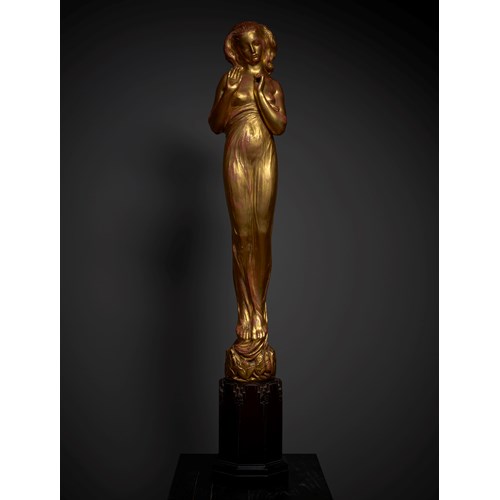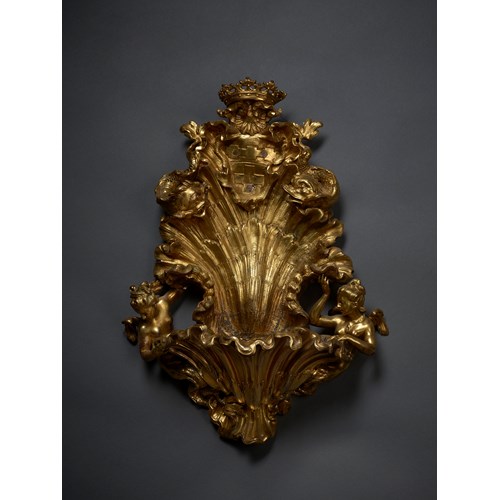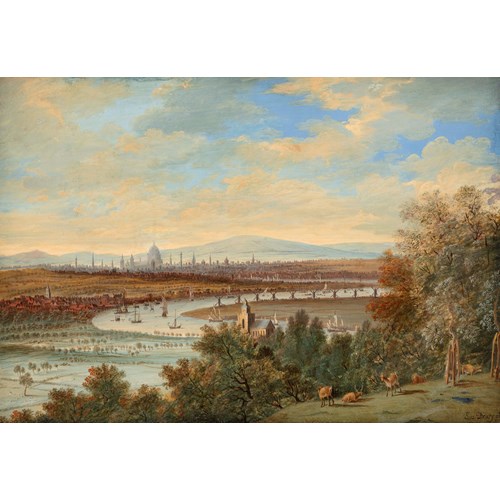Auguste RODIN
Femme nue debout, de profil à droite (découpage)
Medium Graphite and watercolour on paper with white heightening
Dimension 32 x 13.3 cm (12⁵/₈ x 5¹/₄ inches)
The fragmentary character of this work, exemplifying the unique and intimate practice of paper collage within the great artist’s practice, conveys a very modern sensibility. An important element of his work, but one which he kept close and to himself, he almost never showed them during his lifetime. These works in which he sculpted with scissors, are today considered one of the most innovative aspects of his art and long predate the Cubist papier collés of Pablo Picasso, Henri Matisse, Paul Klee, and Hans Arp. Rodin’s cut-outs “stressed expressiveness over anatomical beauty and correct proportions”.
In the present sheet, the severing of the upper half of the model’s head and her feet at the edges intentional. The model’s pose, back arched, palms pressed against her buttocks, is the primary focus of Rodin’s interest. Highlights of white bodycolor, added to the void between right arm and back, enhance the outer contours. The accentuation of the model’s waist-length tresses and her pubic hair is a typical feature of Rodin’s watercolours of female nudes. The rapidly applied pigment has a life of its own, sometimes overlapping, sometimes missing the sketched outlines of the figure, and creating fresh contours, in particular around the buttocks and legs. “Mes dessins sont la clé de mon oeuvre”,[1] Rodin noted in 1910. His remark underlines the central importance of drawing as part of his oeuvre. What attracted him to the medium was its two-dimensionality. Sculpture can be viewed from different vantage points, but a drawing can only be viewed from a predetermined viewpoint – the viewer is obliged to give his full, undivided attention to the viewpoint that the artist has selected. The photographs Rodin instructed his friend Edward Steichen to take of his sculptures fascinated Rodin similarly. His aim was not to dampen associative responses in the viewer but instead, to establish a mutual starting point from which both sculptor and viewer could embark on a receptive experience.
Most of Rodin’s drawings depict the human figure, albeit with very different creative intentions. The present sheet is the culmination of a new activity he began in 1896 – drawing blind “l’aveugle”. This involved never shifting his eyes from the model and sketching rapidly without for a moment looking at the drawing. Nothing, he felt, should be allowed to interrupt the flow of feeling from eye to hand. He wanted to absorb the secrets of the human form, to capture the essence of a pose intuitively. One of these sketches, now in the collection of the Musée Rodin, is immediately preparatory to the present découpage. Hallmarks of the esquisses l’aveugle are undulations, exploratory shifts and reprises. They are spontaneous sketches which were often reworked with the help of tracing paper. He would smoothen and refine a drawing that pleased him, preserving only the essentials – such as the interplay between the contours of the model’s back and right arm in the present sheet. The left arm in the void between the model’s right arm and back has been masked with a thin layer of white bodycolor, thereby intensifying the contours of the figure. Delicate touches of the brush accentuate the waist-length, brownish-black tresses. Tiny strokes of grey-brown add density to the pubic hair, which is absent in the preliminary graphite sketch. The present découpage is closely related to a marble version of Psych-Pomone executed in 1904-6 and now housed in the Musée Rodin in Paris. The figure emerges from the marble in Michelangelesque non-finito, right arm bent, back arched and head turned to the right.
Rodin’s delineated restraint and employment of flat, un-modelled watercolour wash heightens the sense of two-dimensionality. He deliberately dispenses with a background so that the figure seems detached from pictorial space. The decoupages that Rodin produced between 1885 and the early 1890s occupy a unique role within his body of drawings most of which are depictions of the female nude. Once a drawing was completed, he would cut the figure out and then begin to experiment with its spatial arrangement or position in relation to other figures. He would do the same with his sculptures, setting them up in new groups and different spatial settings.
Photographs of the sculptures were handled similarly. He would cut the sculptures out and insert them into settings of his own creation or mount them in prints, for example vignettes. In retrospect, it could be said that Rodin was the inventor of the dessin découpage and the related pasting and mounting techniques that were to appear in different contexts throughout modernism. After 1900, finally realising the importance of drawing to Rodin’s masterly and innovative sculptural practice, every major national and international exhibition of his sculptures began to include substantial groups of drawings and watercolours, often thematically arranged.
Despite the importance of his drawings gaining traction amongst critics and collectors, the cut-outs nonetheless were rarely exhibited - with the present sheet being a possible exception. In 1908 Rodin rented workshops in the Hotel Biron in Paris with other artists including Matisse. It was during this time, as Elsen has demonstrated in his study of Rodin’s work, that Matisse undoubtedly discovered Rodin’s work and it was instrumental in the development of his own famed paper cut-out technique.
Medium: Graphite and watercolour on paper with white heightening
Dimension: 32 x 13.3 cm (12⁵/₈ x 5¹/₄ inches)
Provenance: Private Collection Munich until 2010, likely purchased prior to the 1990s,
Private Collection, Munich, purchased from the above estate, until 2021
Literature: Catalogue raisonné des dessins et peintures d’Auguste Rodin (1840 – 1917), No.
201201.
Exhibition: Requested for loan for the Rodin exhibition to be held at the Musée des Beaux-Arts in Mons, Belgium (BAM), 13th April to 18th August 2024
More artworks from the Gallery


_T638676151429242934.jpg?width=2000&height=2000&mode=max&scale=both&qlt=90)




_T638354709335648178.jpg?width=500&height=500&mode=pad&scale=both&qlt=90&format=jpg)

